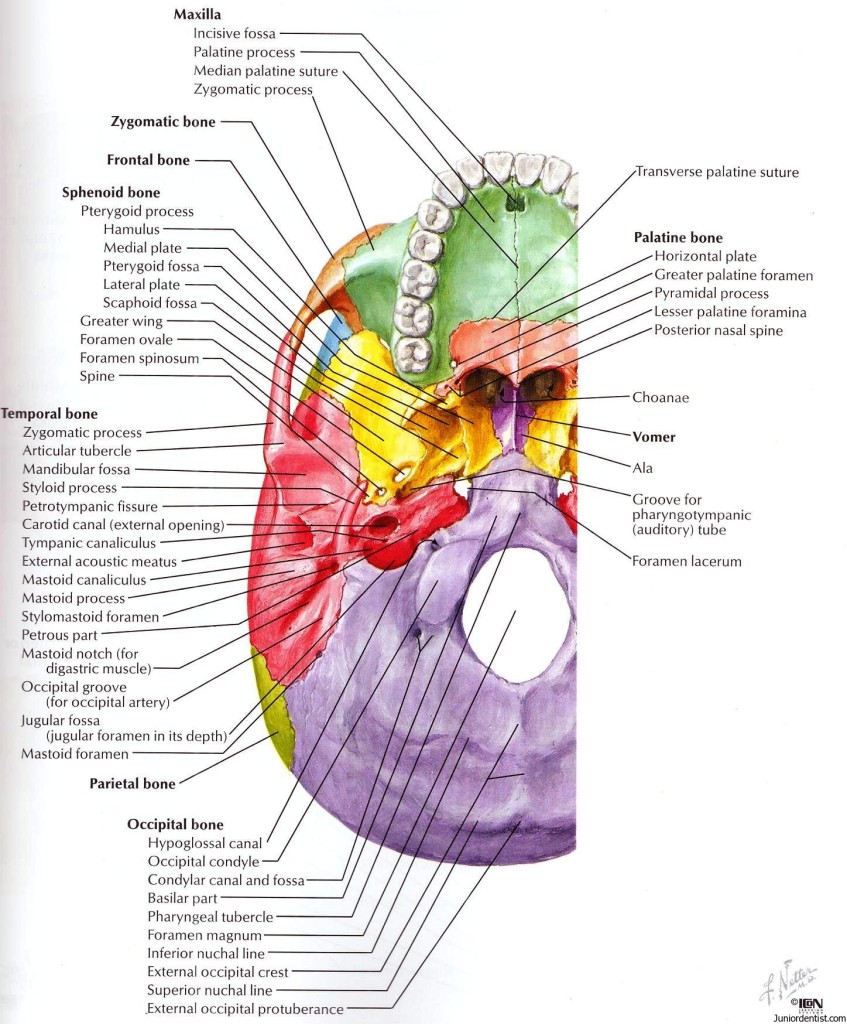What is a Foramen: An Opening or Orifice in the skeleton through which structures like Nerves, Arteries, Veins, Muscles and Ligaments pass. There are multiple such foramens on the lower aspect of the skull which act as pathways for the various structures which pass through them. The Cranium is divided into three parts – Anterior Cranial Fossa, Middle Cranial Fossa and Posterior Cranial Fossa through which various structures (Arteries, Veins and Nerves) pass
So here we have listed out the various Foramens seen in the skull and the structures passing through them separately. There are many Foramen small and big which have structures passing through them and we have listed most of the major and important Foramen in the base of skull and the structures passing through them.
Contents Passing through Foramen of Skull:
Foramen Magnum: The term literally translates to “great hole” in latin which is a large oval foramen at the base of the scull in the occipital bone. The Foramen Magnum is seen in many other animals as well which is the path way for the Spinal cord. It is surrounded by four bones – para squama, left and right pars lateralis and pars basilaris.
- Medulla Oblangata or Spinal Cord
- Vertebral Arteries
- Spinal Accessory nerve
- Apical Ligament of Dens
- Membrana Tectoria
Mandibular Foramen: This is one of the smallest foramen located in the Mandible precisely on the internal surface of the Ramus. The shape of the foramen can be of two types – Horizontal Oval share or V Shape having a groove to seperate the anterior and posterior parts.
- Inferior Alveolar Nerve
- Inferior Alveolar Artery
- Inferior Alveolar Vein
Mental Foramen: It is located on outer or lateral surface of the Mandible, usually in between the roots of the premolars. The opening of the metal foramen is positioned posteriosuperiorly. The location of the mental nerve height varies from age of the patient and also with the resorption of the mandible.
- Mental Artery
- Mental Vein
- Mental Nerve
Parietal Foramen: These are also called as Parietal Foramina and are called so as they are located on the back of the parietal bone close to the upper or sagittal border of the bone. The size varies and in some people it might be absent. The structure passing through it drains into the superior sagittal sinus through this foramen.
- Emissary Vein from superior sagittal sinus
Mastoid Foramen: A hole located in the Temporal bone towards the posterior border of the mastoid process. The size differs from person to person.
- Emissary Vein to Sigmoid sinus
- Meningeal branch of occipital artery
Foramen Cecum: It is defined as a shallow depression in the posterior dorsal midline of the tongue whic is the remnant of the cranial part of the embryonic duct from which the thyroid gland was developed.
- Emissary Vein
Greater Palatine Foramen: The name is given due its location along the greater palatine sulcus of palatine bone inside the posterior hard palate of the greater palatine canal.
- Greater palatine Artery
- Greater Palatine Vein
- Anterior Palatine Nerve
Lesser Palatine Foramen:
- Lesser Palatine Artery
- Lesser Palatine Vein
- Middle and Posterior Palatine Nerves
Incisive Canal:
- Nasopalatine Nerve
- Greater Palatine vessels
Supra Orbital Foramen:
- Supra orbital Nerve
- Supra orbital Artery
- Supra orbital Vein
Superior Orbital Fisure:
- Oculomotor Nerve
- Trochlear Nerve
Abducens Nerve - Trigeminal nerve (V3)
- Superior Opthalmic Vein
- lacrimal, frontal and nasociliary branches of ophthalmic (V1).
Inferior Orbital Fissure:
- Infra Orbital vessels
- Ascending branches of Sphenopalatine ganglion
- Zygomatic Nerve
Foramen Rotundum:
- Maxillary Nerve (V2)
Foramen Ovale:
- Mandibular Nerve (V3)
- Lesser Petrosal Nerve
- Accessory Meningeal Artery
Foramen Spinosum:
- Middle Meningeal Artery
- Middle Meningeal Vein
- Nervous Spinosus
Foramen Lacerum:
- Greater and Deep Petrosal Nerves to form nerve of pterygoid canal
- Meningeal branch of ascending pharyngeal artery
- Internal carotid Artery with Venous and Sympathetic Plexus
Stylomastoid Foramen:
- Facial Nerve
- Posterior Auricular Artery (Stylomastoid branch)
Zygomaticotemporal Foramen:
- Zygomaticotemporal Nerve

thank you ,
Trigeminal v1 passes through superior orbital fissure not v3
Useful
thanks
Thanks alot
thank you
What are the important of long lived contraction and relaxation of the smooth muscle?
thank you so much sir
what of jugular foramen?
Superior orbital fissure also transmits inferior ophthalmic vein; SOF transmits only branches of ophthalmic division of trigeminal (V1) nerve and no contribution from V3
very nyc thnku:-)):-)):-))